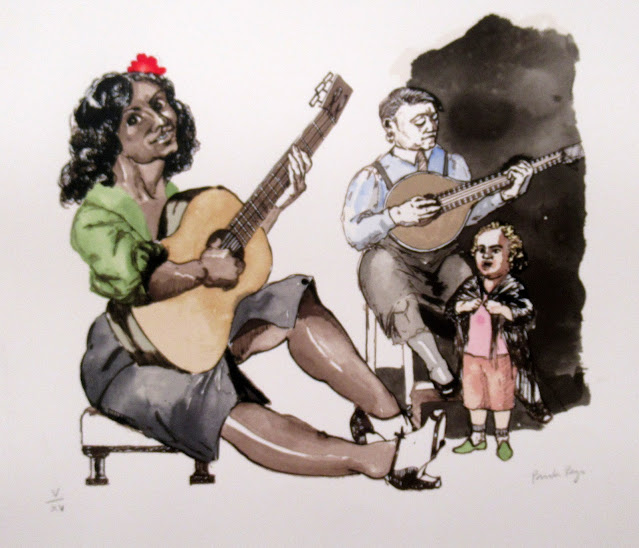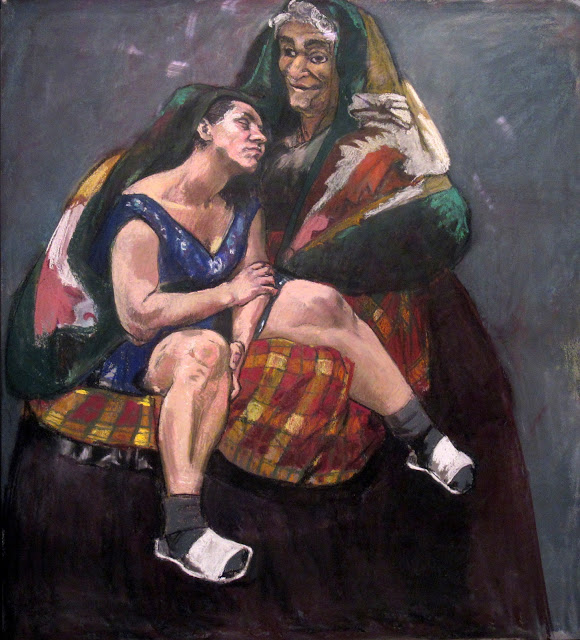I posted on Paula Rego's museum, Casa das Historias, back in July and you can see that post here . I have now, finally, managed to complete the task by blogging on the exhibition inside the museum.
Paula Rego at the Casa das Historias, in Cascais.
Paula Rego is particularly known for her paintings and prints based on storybooks. Her style evolved from abstract towards representation, and she favoured pastels over oils for much of her career. Her work often reflects feminism, coloured by folk-themes from her native Portugal.
Rego used two typical tropes of Western art history: 'the gaze', and 'the reclining nude'. She utilised the gaze in conscious ways to challenge the viewer by having the woman or girl look directly at the viewer or away in agony or closing her eyes in pain. The reclining nude brings up that push and pull between sexual attraction, the act of sex and the physical outcomes like pregnancy and miscarriage that occur as a result of sex.
She was a prolific painter and printmaker, and in earlier years also produced collage work. Her well-known depictions of folk tales and images of young girls, made largely since 1990, brought together methods of painting and printmaking that emphasised strong, clearly drawn forms, in contrast to the looser style of her earlier paintings.
In her earlier works, she was strongly influenced by Surrealism, and particularly the work of joan Miro. This shows itself not only in the type of imagery that appears in these works, but in the method employed, which is based on the Surrealist idea of automatic drawing, in which the artist attempts to disengage the conscious mind from the making process in order to allow the unconscious mind to direct the making of an image. At times these paintings almost verged on abstraction. However, even when her work veered toward abstraction, a strong narrative element remained in place.
A notable change in Rego's style emerged in 1990. The result was a series of works that came to characterise the populat perception of Rego's style, combining strong clear drawing with depctions of equally strong women in sometimes disturbing situations.
September Afternoon, 1960-61, (crayon and paper glued on canvas)
On the Beach, 1985, (acrylic on canvas)
Among the most notable works were those in her Dog Women series, in which women were shown sitting, squatting, scratching, and generally behaving as if they were dogs. This antithesis of what is considered femimine behaviour, and many of her other works in which there appeared to be either the threat of female violence of its actual manifestation, caused Rego to be associated with feminism. Rego acknowledged reading at a young age Simone de Beauvoir's The Second Sex, and that this made a deep impression on her. Her work also seems to chime with the interest in Freudian criticism shown by feminist writers on art in the 1990s, such as Griselda Pollock, with works such as Girl Lifting up her Skirt to a Dog of 1986, and Two girls and Dog of 1987 appearing to have disturbing sexual undertones. However, Rego was known to rebuke critics who read too much sexual content in her work.
Another explanation for Rego's depiction of women as unfeminine, animalistic or brutal beings is that this reflected the physical reality of women as human beings in the physical world, rather than the idealised female type in the minds of men.
N.B.
Even though there were no works from Rego's Abortion Series in this exhibition, I would like to comment on those.
Rego was a critic of the anti-abortion movement, using the theme of abortion as a focal point in much of her art. She opposed the criminalisation of abortion and said that the anti-abortion movement 'criminalises women'. She also stated that the matter disproportionately affected poor women, as for the rich was it easier to find a safe way to have an abortion due to being able to travel abroad for the procedure. She created the Abortion Series documenting illegal abortions in response to Portugal's 1998 referendum on abortion. The referendum aimed to legalise abortions, but the law was not passed.
The series, known as Untitled: The Abortion Pastels show images of women in various positions, such as fetal, squatting, etc. either getting ready to have an abortion, in the process of having one, or in pain from the procedure.
In a 2002 interview Rego stated: 'The series was born from my indignation... It is unbelievable that women who have an abortion should be considered criminals. It reminds me of the past... I cannot abide the idea of blame in relation to this act. What each woman suffers in having to do it is enough. But all this stems from Portugal's totalitarian past, from women dressed up in aprons, baking cakes like good housewives. In democratic Portugal today there there is still a subtle form of oppression. The question of abortion is part of all that violent context'.











































No comments:
Post a Comment